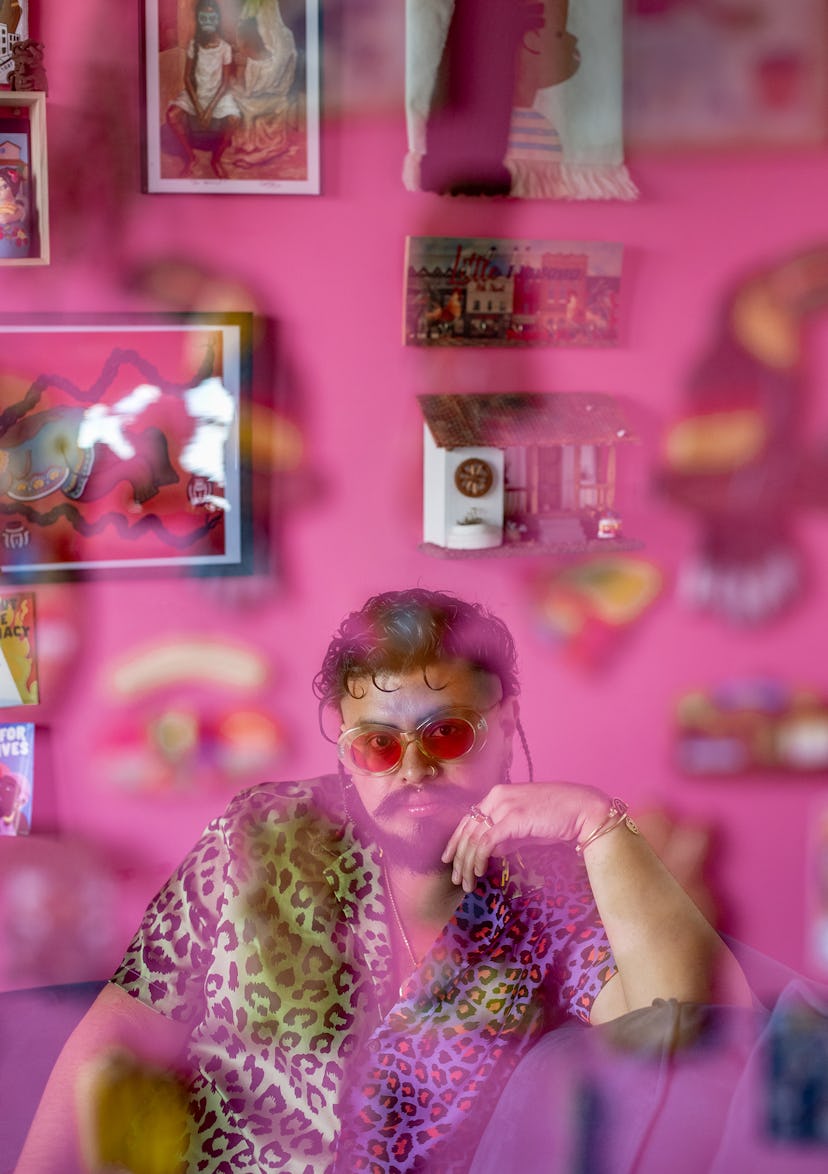Amid a maze of white walls at the New Art Dealers Alliance fair during Miami Art Week in December 2021, there was one pink booth that caught my attention. The brightly colored exhibition titled “La Pulperia Doña Pina,” belonged to the ceramicist Joel Gaitan, along with the Miami-based gallery KDR305. His installation was decorated with a banana stalk, terra-cotta-tiled roofing, and shelves of colorful Central American snacks and condiments—all surrounding a selection of terra-cotta sculptures that simultaneously paid tribute to, defied, and expanded upon the history of Mesoamerican ceramics. (His exhibition was among a special selection made by 52 Walker’s Ebony L. Haynes to present at NADA Miami and highlight emerging artists.) I met Gaitan, 26, later that month in Little Havana, Miami near his home. With chartreuse-dyed hair and matching chartreuse sunglasses, he was as energetic, playful, and curious as his sculptures had appeared to me weeks before.
Born in Hialeah, Florida to Nicaraguan parents, Gaitan remembers always being drawn to clay. “When I was at church as a child they would say, ‘Pray to God for what you want.’ I always wanted Play-Doh,” he said. “And I would get my Play-Doh every Sunday.” He attributed his interest in art to his ancestral heritage and family lineage, going back to his grandfather, who was a musician and painter. His ancestry, and Nicaragua’s native history, are both central themes in Gaitan’s work: He creates pieces using traditional hand-building techniques, and “La Pulperia Doña Pina,” is named after his aunt, Doña Pina, who runs a pulperia (a store similar to a bodega that sells food and beverages) in Managua, Nicaragua.
“The art has always been there. We all have it. It’s just that certain things wake it up,” Gaitan said. “And for me, the church woke it up. Knowing about my grandfather, and my family in Nicaragua, woke it up. My parents’ story, their migration here, woke it up. My work is extremely spiritual. It is a way to reclaim our people and get back to our people. To give them praise. [...] I believe that when I work, I am guided by the spirits. That’s why I don’t need inspiration to start with a ball of clay. I just start, and de ahi, I’m not scared of what comes out because I know that I will be guided.”
The spiritual nature of Gaitan’s works shows through especially when it comes to the history of Mesoamerican pottery and its ties to indigenous spiritual practices. Pieces like “La Mayahuel” and “Venus de Managua” bring to mind sculptures of Aztec deities like Tlazolteotl, the goddess of childbirth and purification, who is often depicted in a frontal child-bearing position with a human head between her legs. (Depictions of Tlazolteotl have been featured in works like Diego Rivera’s “The History of Medicine in Mexico: The People’s Demand for Better Health,” and was famously referenced by Steven Spielberg in his film “Raiders of the Lost Ark.”)
Joel Gaitan’s works “La Mayahuel” and “Venus de Managua.”
His involvement with NADA Miami and KDR305 cast deserving light onto his work—he’s even picked up another show, titled “Lágrimas de Oro,” which opens March 26th at 56 Henry gallery in New York. “His work is like looking at museum artifacts in a new way,” the founder and director of KDR305, Katia Rosenthal, said of Gaitan’s ceramic sculptures “I thought instantly that his work could be put behind specimen cases in a museum like The Met. It’s so interesting that somebody this young is still drawing connections to the past and staying true to his culture and staying true to himself.”
But Gaitan does not only draw upon the past; he also looks inward, toward himself and who he is at present. His works involve personal themes of identity and his own explorations of sexuality. “Those [ceramics] are all studies of what sexuality is [based on] my own research and personal experiences. They’re even a form of self-pleasure,” Gaitan said. “I have one piece called ‘Feet Boy’ where it’s one pot with two heads, and they’re sucking on each other’s feet.” His sense of humor toward sexuality comes through in other pieces that depict pots engaging in fellatio or masturbation.
When asked how he sees his work evolving next, Gaitan said he wants to explore larger scales and bring different stories into his pots. “I’m not into simple display, I’m into heavy storytelling,” he added. “I love to take up space and I like to represent the unrepresented.” The stories he seeks to tell come specifically from the many countries that make up Latin America—although we both agreed that using the term “Latin” does a disservice to the immense diaspora of cultures that exist in Central America, South America, and the Caribbean; including those that existed way before their Colonial and Latin rule.
“My thing is, we get stuck in this Latinidad box, but in reality, we are so different from each other. And it’s no offense to anybody that comfortably identifies as Latina (a/o/x). It’s a comfort term because people often don’t give a shit about learning different cultures,” Gaitan said. “My goal is to break out of this Latindad culture. I’m Nica. And I want you to learn what that means. You’re going to eat my food. You’re going to learn how to pronounce [things] right. I want our foods and our arts to be considered high-end. We are as high-end as they come."
Joel Gaitan in his home in Little Havana.
